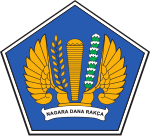The Jakarta metropolitan area or Greater Jakarta, known locally as Jabodetabek (an acronym of Jakarta–Bogor–Depok–Tangerang–Bekasi), and sometimes extended to Jabodetabekjur (with the acronym extended to include part of Cianjur Regency), or Jabodetabekpunjur (further extended to include Puncak and the Cipanas district), is the most populous metropolitan area in Indonesia. It includes the national capital (Jakarta Special Capital Region, as the core city) as well as five satellite cities and three complete regencies. The original term "Jabotabek" dated from the late 1970s and was revised to "Jabodetabek" in 1999 when "De" (for "Depok") was inserted into the name following its formation. The term "Jabodetabekjur" or "Jabodetabekpunjur" was legalised on the Presidential Regulation Number 54 of 2008, although the name Jabodetabek is more commonly used.
The area comprises Jakarta Special Capital Region and parts of West Java and Banten provinces, specifically the three regencies - Bekasi Regency and Bogor Regency in West Java, and Tangerang Regency in Banten. The area also includes the independent cities of Bogor, Depok, Bekasi, Tangerang and South Tangerang, all of which are not included administratively in the regencies. The name of the region is taken from the first two (or three) letters of each city's name: Ja-bo-de-ta-bek from Jakarta, Bogor, Depok, Tangerang and Bekasi.
The population of the Jakarta metropolitan area, with an area of 6,437.68 km2 (2,485.60 sq mi), was 31.24 million according to the Indonesian 2020 Census, making it the most populous region in Indonesia, as well as the second-most populous urban area in the world after Tokyo. The Jakarta metropolitan area's share of the national population increased from 6.1% in 1961 to 11.26% in 2010. The population grew further to 31.53 million according to the official mid 2021 Estimates.The region is the centre of government, culture, education, and economy of Indonesia. It has pulled many people from throughout Indonesia to come, live and work. Its economic power makes Jakarta metropolitan area the country's premier centre for finance, manufacturing and commerce. In 2019 data,
The area has a gross domestic product of US$297.7 billion with a per capita GDP of $8,775, and a purchasing power parity of US$978.5 billion with a per capita PPP of $28,840, equal to 26.2% of economy of Indonesia.
The region was established in 1976 through Presidential Instruction No. 13 in response to the needs to sustain the growing population of the capital city. Indonesia's government established the Jabotabek Cooperation Body (Badan Kerjasama Pembangunan) of the joint secretariat of Government of DKI Jakarta and West Java province.











